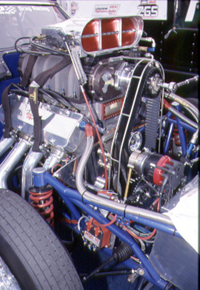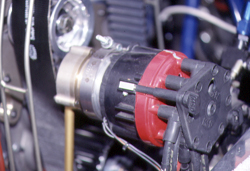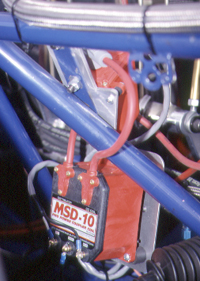|
|
|
|||||
Come On Baby,
|
||||||
|
The NMCA’s Outlaw Street is a class populated by racers who have taken the path less traveled and found success (or at least fun and interesting challenges) with chassis and engine combinations that others wouldn’t think of using. If fact, their operative philosophy seems to paraphrase an old movie line: "Rules? We don’t need no stinkin’ rules!" As a result, you’ll find Outlaw Street racers driving everything from tubocharged, small block-powered late model pickups to nitrous oxide-injected, rat-motored ’48 Chevy panel trucks. And then there is Gladys Giddy-Up, Bruce Kimmen’s supercharged, flamed, flying brick of a ’69 Camaro. The powerplant and ignition in Kimmen’s Camaro comprise one of those unusual Outlaw Street combinations. The boxy Camaro weighs in at 3100 pounds and probably has a drag coefficient about that of a Greyhound bus. Yet as this story is written, Kimmen and his band of merry men have gone a best of 6.83/211 and the team consistently runs in the 6.90s at more than 200 mph. As a result of his performance, the fans voted Bruce Kimmen the 1999 Car Craft All-Star Outlaw Street Driver of the Year award.
To run those speeds with a heavy, aerodynamically challenged car like Gladys, Kimmen’s blown 526-inch Olds/Chevy engine has to make more than 2200 horsepower. Kimmen definately tok the road less traveled when it came to an ignition to support a 2000+ horsepower supercharged engine. Kimmen’s engine gets its fire from a capacitive-discharge (CD) ignition originally designed by MSD to be used for nitrous oxide injection applications.
It is generally believed that if an engine is turbocharged or supercharged and has a lot of compression, boost, and fuel volume, it requires an inductive coil-style magneto ignition. The reasoning for this is that most engine agree that an alky- or nitro-burning engine needs the long-duration, high-energy spark that a magneto-ignition system delivers in order to burn fuel. When Kimmen built his Camaro he would have preferred to use one of MSD’s 44-amp magnetos on the motor. Three factors, however, made him look for an alternative: the weight, length, and cost of the mag. The MSD mag was too heavy, too long to fit on the front of Kimmen’s engine, and it cost almost three times as much as the alternative. So, following some experimentation and consulting with MSD engineers, Bruce went with the MSD-10 ignition, So far, it has delivered everything his blown engine needs.
Many tuners feel that without a magneto ignition, a blown alky engine will drop holes (not fire the fuel/air mixture in one or more cylinders) during a pass. But this hasn’t been a problem for Kimmen. Not only has the team not had a single ignition failure since installing the MSD-10, but Kimmen’s crew chief said that he has been able to run more fuel volume through the engine than he could with the ignition system that previously fired the blown motor. That means that the engine is making more power than before. The MSD-10 originally was developed for the nitrous oxide-injected mountain motors used in IHRA Pro Modifieds and Pro Stocks. It was designed with the nitrous engines in mind because those engines make their horsepower by injecting a very high-volume, high-pressure stream of nitrous oxide and gasoline into the intake. Injecting liquid nitrous oxide and gasoline into an engine that has 15 points of static compression creates combustion chamber turbulence that makes it difficult for an ignition and spark plug to do their jobs. The MSD engineers developed the ignition as an extreme-duty CD system designed to deal with just such an environment. The MSD-10 ignition differs from other CD ignition systems in that it has two types of coils firing each spark plug. One is a standard capacitive discharge-style coil, and the other is a highly modified inductive-style coil like those used with magneto ignitions. Dual coils offer the tuner an advantage over the standard single coil ignition. This system delivers the best functions of both types of ingitions. The MSD-10 also offers the engine tuner a unique option. By ordering the induction coil wound to different ratios, the spark current and duration can be custom-matched to the specific demands of an engine combination. Additionally, the system can be set up to deliver the hot, long-duration spark that a magneto delivers, or it can be set up to function as an ultra-powerful CD style ignition. The ignition can deliver as much as 520 volts to the coils, which makes a hotter, fatter spark that resists being blown out by combustion chamber turbulence or doused by too much fuel. Both are common problems in supercharged or heavily nitroused engines.
The power generated by the MSD-10 can be illustrated by the amount of energy the system delivers to the plug - between 315-345 millijoules of spark energy for up to 30 degrees of crank rotation. By comparison, the MSD-7AL-3 delivers 160 millijoules at the plug and sustains the spark for 20 degrees of crank rotation. One of the inherent problems of a typical conductive-type ignition is the time required for the coil to recharge. This time can be lengthy and can lead to misfires at high rpm. But the unique dual-coil system of the MSD-10 promotes much faster rise time. That means more output voltage at all rpm ranges, especially above 700 rpm. The MSD-10 ignition system sell for about $1000 for a complete system that includes the built-in two-step rev limiter. The complete system weighs 4.75 lbs. By comparison, an MSD 44 amp ignition system without a retard system sells for approximately $2500 and weighs considerably more. For the racer who needs a powerful and lightweight ignition system that will work with either a supercharged or high performance nitrous oxide-injected engine, the MSD-10 ignition seems to offer an attractive option.
photos by Jeff Burk
|
||||||
|
Copyright 1999, Drag Racing Online and Racing Net Source |
||||||



